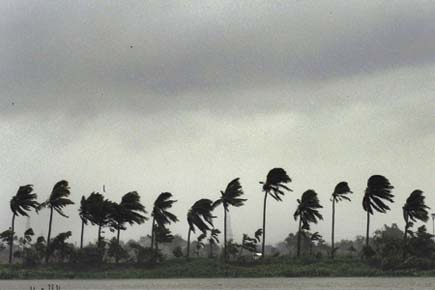There was no intimation of a storm when I left home for work. It was only after I hit the Expressway that I spotted the dark, menacing storm, roaring across the highrise-dotted dust plains that separate Delhi from Uttar Pradesh

 There was no intimation of a storm when I left home for work. It was only after I hit the Expressway that I spotted the dark, menacing storm, roaring across the highrise-dotted dust plains that separate Delhi from Uttar Pradesh. Within seconds, an all-engulfing darkness descended at high noon and gale force winds swept down, whooshing their way through trees and scrub, scooping up dirt and millions of discarded plastic bags, and sending them swirling in the gathering gloom.
There was no intimation of a storm when I left home for work. It was only after I hit the Expressway that I spotted the dark, menacing storm, roaring across the highrise-dotted dust plains that separate Delhi from Uttar Pradesh. Within seconds, an all-engulfing darkness descended at high noon and gale force winds swept down, whooshing their way through trees and scrub, scooping up dirt and millions of discarded plastic bags, and sending them swirling in the gathering gloom.
ADVERTISEMENT

Pic/AFP
Mercifully, the rain came soon after. First there were fat drops that plonked dully on the windscreen and turned into streaks of black-brown grime. There was a distant roll of thunder, and then the skies opened up, sending a sharp and short downpour that came crashing like a sheet of water. Within seconds, the stench of festering garbage had been washed away and the plastic bags had disappeared, weighed down by the rain. Later that night, the roads looked fresh and clean, with puddles glistening under streetlights and the damp air redolent with the smell of rain.
Similar storms at this time of the year are joyously greeted in the eastern hinterland, especially in rural Bengal where they herald the advent of summer. As Choitro gives way to Boishakh, marking the end of spring, Kaal Boishakhis, or nor’westers, make their annual, almost ritual, appearance.
The skies turn dark, egrets take flight, their sparkling white plume standing out in sharp contrast to the ink black clouds, and the wind comes roaring, whistling through coconut and palm trees, in a strong blast that lasts for about five to ten minutes. This is followed by a sharp drizzle that drenches the soil, dampens the air and cools the evening breeze which makes east India so very different from the rest of the country, more so Delhi, India’s dust bowl.
Decades ago, while growing up in Jamshedpur, my friends and I would wait for Kaal Boishakhis with bated anticipation. The immediate hour after a Kaal Boishakhi would be spent collecting green mangoes, raw and sour, which were otherwise forbidden, torn off their tender stalks by the raging wind. There was something Darwinian about the mango trees in our colony: The fittest fruit survived the frenzied storms of Boishakh to mature into delightfully sweet mangoes in the scorching heat of Joishtho. But they never tasted as good as the forbidden fruit.
It was during those years of growing up in a small Singhbhum town that we learned the art of grating a seashell on a rock with a rough surface to fashion a peeler for the green mangoes we would surreptitiously collect from Mrs Chowdhury’s garden. She had a dog whom she fed Ovaltine and milk for breakfast; Badshah slept all the time and wagged his tail furiously while we stole Mrs Chowdhury’s mangoes. She would be busy dusting her house — which she kept spotlessly clean — after the storm. As soon as a Kaal Boishakhi would pass, Mrs Chowdhury would switch on her gramophone at full volume and listen to Rabindrasangeet on 78 rpm records. Her favourite was ‘Esho hey Boishakh, esho esho...”
On Kaal Boishakhi evenings, dinner would be predictable — and, I guess, they still are predictable in Bengali homes that have not traded their Bangaliana for tandoori chicken and daal makhni. It would invariably arrive on the table in the form of steaming khichuri, begun bhaja and papor bhaja. The highlight of the meal would be an omelette. On some nights, the omelette would be replaced by fried hilsa from Kolaghat.
The ersatz benefits of living in India’s National Capital Region stops me from going back to the land of Kaal Boishakhis where I could teach my daughters how to make peelers from seashells and they could smell the fragrance of rain-sodden earth while collecting green mangoes and chasing dragonflies in the purple light of east India’s dusk before settling down for a steaming meal of khichuri, begun bhaja and omelette, listening to the strains of ‘Esho hey Boishakh, esho esho…’ playing on a neighbour’s gramophone.
The writer is a senior journalist based in the National Capital Region. His Twitter handle is @KanchanGupta
 Subscribe today by clicking the link and stay updated with the latest news!" Click here!
Subscribe today by clicking the link and stay updated with the latest news!" Click here!







